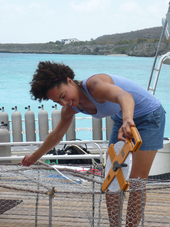Highlight
Reducing Bycatch without reducing value
Achievement/Results
Fishing with traps occurs daily on coral reefs all over the world. For the last century, traps have been responsible for a large portion of catch in the Caribbean, and in Curaçao, traps account for more than half of reef fish landings by weight. Trap fishing is notable for its high level of bycatch – traps capture many juvenile and narrow-bodied fishes that are neither desired by fishermen nor desirable as food.
Ayana Johnson, IGERT Associate, experiment on the selectivity of fish traps was inspired a fishery ordinance recently proposed by Curaçao’s fishery department. The ordinance includes a requirement that all fish traps have a 20 cm by 2.5 cm gap to allow juveniles and narrow-bodied species to escape. While it is intuitive that such an escape gap would be effective, supporting scientific evidence did not exist. To provide information on the potential ecological and economic implications of a mandated change in trap design, she compared the catch of traditional traps to the catch of traps with escape gaps.
The most important finding of this study is that fishermen could use escape gap traps without decreasing their incomes, because although they would catch fewer low-value fishes and fewer narrow-bodied fishes, the overall mean catch value was not significantly different between trap types. This bycatch reduction is a win-win situation for fishermen and conservation. Fishermen can catch half as many fishes and still make the same amount of money. Fishermen would also reap a longer-term benefit: the juveniles of high-value species that escape via the gaps would be allowed to grow to a more marketable size, and perhaps reproduce, before being caught by a trap with escape gaps.
Potential Benefits of Trap Modification Switching to traps with escape gaps would have a large effect on coral reef fish populations. Since a trap with large gaps catches a mean of 6.3 fewer fishes than a control trap, retrofitting 10,000 traps (a very low estimate for the number of active traps in the Caribbean) fish traps that each fish 100 days out of the year could reduce bycatch by 6,300,000 fishes. That would have a large impact on coral reef fish populations. Because traps can be easily and cheaply modified to reduce bycatch without reducing catch value, this research has the potential to not only support regulations on the island of Curacao, but also hopefully influence management of trap fishing in many other locations.
Address Goals
An advantage over the single subject research area, NSF IGERT students are free to examine ecology and socioeconomics or fisheries ecology and history. Solutions are being found through these interdisciplinary investigations.








